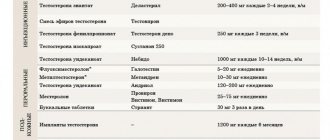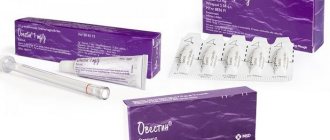L-Thyroxin
The use of tricyclic antidepressants with levothyroxine sodium may lead to increased effects of the antidepressants.
Levothyroxine sodium reduces the effect of cardiac glycosides.
When used simultaneously, cholestyramine and colestipol (ion exchange resins) reduce the plasma concentration of levothyroxine sodium by inhibiting its absorption in the intestine. In this regard, levothyroxine sodium should be used 4-5 hours before taking these drugs.
When used simultaneously with anabolic steroids, asparaginase, tamoxifen, pharmacokinetic interaction is possible at the level of binding to plasma proteins.
Protease inhibitors (eg, ritonavir, indinavir, lopinavir) may affect the effectiveness of levothyroxine sodium. Close monitoring of thyroid hormone concentrations is recommended. If necessary, the dose of levothyroxine sodium should be adjusted.
Phenytoin may affect the effectiveness of levothyroxine sodium due to the displacement of levothyroxine sodium from plasma proteins, which can lead to an increase in the concentration of free T4 and T3. On the other hand, phenytoin increases the rate of metabolism of levothyroxine sodium in the liver. Close monitoring of thyroid hormone concentrations is recommended.
Levothyroxine sodium may reduce the effectiveness of hypoglycemic drugs. Therefore, frequent monitoring of blood glucose concentrations is necessary from the start of thyroid hormone replacement therapy. If necessary, the dose of the hypoglycemic drug should be adjusted.
Levothyroxine sodium may enhance the effect of anticoagulants (coumarin derivatives) by displacing them from plasma proteins, which may increase the risk of bleeding, such as cerebral hemorrhage or gastrointestinal bleeding, especially in elderly patients. Therefore, regular monitoring of coagulation parameters is necessary both at the beginning and during combination therapy with these drugs. If necessary, the dose of the anticoagulant should be adjusted.
Salicylates, dicumarol, furosemide in high doses (250 mg), clofibrate and other drugs can displace levothyroxine sodium from binding to plasma proteins, which leads to an increase in the concentration of the free T4 fraction.
Sevelamer may reduce the absorption of levothyroxine sodium.
Tyrosine kinase inhibitors (eg, imatinib, sunitinib) may reduce the effectiveness of levothyroxine sodium. Therefore, at the beginning or at the end of a course of concomitant therapy with these drugs, it is recommended to monitor changes in thyroid function in patients. If necessary, the dose of levothyroxine sodium is adjusted.
Aluminum-containing drugs (antacids, sucralfate) are described in the literature as potentially reducing the effectiveness of levothyroxine sodium. Therefore, it is recommended to take levothyroxine sodium at least 2 hours before using these medications. This recommendation also applies to the use of medications containing iron and calcium salts.
Somatropin, when used simultaneously with levothyroxine sodium, can accelerate the closure of epiphyseal growth plates.
Propylthiouracil, glucocorticosteroids, beta-sympatholytics, iodine-containing contrast agents and amiodarone inhibit the peripheral conversion of T4 to T3.
Due to the high iodine content, the use of amiodarone may be accompanied by the development of both hyperthyroidism and hypothyroidism. Particular attention should be paid to nodular goiter with the possible development of unrecognized functional autonomy.
Sertraline, chloroquine/proguanil reduce the effectiveness of levothyroxine sodium and increase the concentration of TSH in the blood serum.
Drugs that induce hepatic enzymes (eg, barbiturates, carbamazepine) may enhance the hepatic clearance of levothyroxine sodium.
In women using estrogen-containing contraceptives or in postmenopausal women receiving hormone replacement therapy, the need for levothyroxine sodium may be increased.
Consumption of soy-containing products may reduce the intestinal absorption of levothyroxine sodium. Therefore, dosage adjustments may be necessary, especially when starting or stopping consumption of soy-containing products. With simultaneous use of orlistat and levothyroxine sodium, hypothyroidism may develop and/or a decrease in the control of hypothyroidism may occur. The reason for this may be decreased absorption of iodine salts and/or levothyroxine sodium. Patients taking levothyroxine sodium should consult their physician before starting orlistat as it may be necessary to take orlistat and levothyroxine sodium at different times of the day and the dose of levothyroxine sodium may need to be adjusted. Further monitoring of thyroid function is recommended.
Indications for Thyroxine
As a rule, Thyroxine is included in the basis of hormonal replacement treatment for decreased thyroid function. In addition, taking the medicine is relevant for the following conditions:
- Hypothyroidism of various origins.
- Excess body weight and pronounced signs of cretinism, provoking the appearance of thyroid hypothyroidism.
- Cerebral-pituitary pathological conditions.
- Prevention of the occurrence of nodular goiter due to surgery on the organ.
- Therapy of diffuse goiter.
- Treatment of malignant tumor of the thyroid gland.
- Graves pathology.
- Euthyroid proliferation of the gland.
Instructions for use of L Thyroxine
According to the instructions, the drug should be taken on an empty stomach half an hour to an hour before meals, washed down with small amounts of still water. It is recommended not to chew the tablets. The therapeutic dose and course duration are determined by a specialist depending on the clinical indications.
As a replacement treatment, the drug is prescribed to patients under 55 years of age who do not have problems with the cardiovascular system at a dose of 1.6-1.8 mcg/kg. If there are any diseases and the patient is over 55 years old, the therapeutic dosage is halved.
For the treatment of congenital hypothyroidism, the dose of the drug is calculated taking into account the weight and age of the patient. The drug can be prescribed to children from the first days of life. As a rule, for such a condition, Thyroxine tablets are used for life.
For the treatment of thyrotoxicosis, the drug is simultaneously combined with antithyroid drugs after achieving the euthyroid process.
Side effects of L Thyroxine
If you take the drug under the vigilant supervision of a doctor and follow all his recommendations, taking the drug does not cause any side effects. Otherwise, symptoms of an allergic reaction are observed - skin rash, hyperemia, itching, urticaria.
Other symptoms occur with a high dose or incorrect treatment tactics. They appear rarely and represent the following conditions:
- Headache, tremors of extremities, anxiety, excitement, sleep disturbance.
- Cardiac disorder - arrhythmia, palpitations, angina pectoris, tachycardia.
- Dyspeptic manifestations.
- Pathological course of menstruation.
- Allergic symptoms.
- Excessive sweating, weight loss, fever, constant weakness, fever.
Special instructions for the use of Levothyroxine sodium
Caution should be exercised when prescribing to elderly patients, patients with angina pectoris, hypertension (arterial hypertension), epilepsy, adrenal and pituitary insufficiency, and diabetes mellitus. If signs of hyperthyroidism appear during treatment with levothyroxine, it is recommended to reduce the daily dose or interrupt its use for several days. If side effects disappear, treatment can be gradually resumed. In children, the administration of levothyroxine in a high initial dose can lead to impaired renal function. There may be an increase in the frequency of seizures in children with epilepsy. During pregnancy and breastfeeding, levothyroxine therapy is continued under medical supervision. Levothyroxine has been well studied, so there is no reason to assume that it has embryotoxic and teratogenic properties.
Contraindications
Absolute contraindications to the use of Thyroxine are:
- Acute myocardial infarction.
- Severe inflammatory lesions of the heart.
- Thyrotoxicosis, which has not previously been treated.
- Galactose deficiency.
- Impaired absorption of substances by the intestinal walls.
- Individual intolerance to the active substance.
- Kypocorticism.
It is necessary to take the drug with extreme caution in patients suffering from severe diseases of the heart and blood vessels, diabetes mellitus, and a severe form of hypothyroidism with a prolonged course of the process. In this case, patients need to change the therapeutic dose and duration of the therapeutic course.
Use of the drug Levothyroxine sodium
Inside. The daily dose is set individually depending on the indications, effectiveness and laboratory data. For hypothyroidism, the initial daily dose for adults is 25-100 mcg, maintenance - 125-200 mcg. In severe and long-term hypothyroidism, treatment begins with a lower initial dose, gradually increasing it to a maintenance dose. For children, the initial dose is 12.5–50 mcg/day, maintenance - depending on age: for newborns - 4 mcg/kg, children under 3 months - 25 mcg, from 6 months to 1 year - 37.5 mcg , up to 5 years - 50 mcg, from 5 years to 7.5 years - 75-100 mcg, from 7.5 to 12 years - 100 mcg. For euthyroid goiter, adults are prescribed 75-200 mcg/day, newborns - 12.5 mcg/day, children aged 3 months to 1 year - 37.5 mcg, up to 5 years - 25-62.5 mcg, from 7. 5 years to 12 years – 5–100 mcg/day. For thyroid cancer after surgical treatment, 150–300 mcg/day of levothyroxine is prescribed. The duration of treatment ranges from several months to several years.
Pharmacological properties of the drug Levothyroxine sodium
Synthetic levorotatory isomer of thyroxine (T4), a thyroid hormone. Levothyroxine has all the properties of an endogenous hormone. After biotransformation in the body into liothyronine, it stimulates tissue growth and differentiation, increases tissue oxygen demand, stimulates the metabolism of proteins, fats, carbohydrates, and increases the functional activity of the cardiovascular and central nervous systems. In high doses, it inhibits the production of thyrotropin-RF by the hypothalamus and TSH by the pituitary gland. Absorption of levothyroxine after oral administration is variable and may be reduced in patients with malabsorption syndrome, congestive heart failure, or diarrhea. Bioavailability is 50–80%. More than 99% of levothyroxine is bound to plasma proteins (thyroxine-binding globulin, thyroxine-binding prealbumin and albumin). In various tissues, approximately 80% of levothyroxine is monodeiodinated to form 3,5,3′-triiodothyronine (T3) and inactive compounds. T4 and T3 in the liver are conjugated with glucuronic and sulfuric acid and excreted in bile, a small amount of levothyroxine undergoes deamination and decarboxylation to form tetraiodothyroacetic acid. About 15% of the administered dose is excreted in urine and bile in the form of conjugates and unchanged. They undergo enterohepatic circulation followed by hydrolysis in the intestine and reabsorption. Iodine released during metabolism is utilized for the synthesis of thyroid hormones and is partially excreted in feces and urine. The half-life of levothyroxine is 6–7 days in patients with a euthyroid state, 9–10 days in a hypothyroid state, and 3–4 days in a hyperthyroid state. The half-life of T3 is 1–2 days. Thyroid hormones do not cross the placenta and are excreted only in minimal quantities in breast milk. The action of levothyroxine develops more slowly than liothyronine, but its duration of action is longer than that of liothyronine. The full therapeutic effect from the use of levothyroxine develops no earlier than 1–3 weeks after the start of therapy when taken orally and persists for approximately the same time after its discontinuation. The effect of intravenous administration of levothyroxine to patients with myxedema who are in a comatose state develops within 8 hours, the maximum effect is after 24 hours.
Levothyroxine sodium overdose, symptoms and treatment
Accompanied by symptoms of hyperthyroidism (weight loss, palpitations, sinus tachycardia, arrhythmia, angina pectoris, heart failure, tremor, headache, insomnia, heat intolerance, fever, irritability, diarrhea, abdominal pain); increased levels of T3 and T4 in the blood serum and free thyroxine index. Depending on the severity of symptoms, it is recommended to reduce the dose or temporarily discontinue levothyroxine. If clinical symptoms are pronounced, the stomach is washed, cholestyramine, β-adrenergic receptor blockers are prescribed, and oxygen therapy is performed. Thyrostatic drugs are not used. In case of acute poisoning (suicide attempt), plasmapheresis is recommended.
List of pharmacies where you can buy Levothyroxine sodium:
- Moscow
- Saint Petersburg



![Table 2. Comparison of the antiviral effects of some antiseptics [R. Kawana et al., 1998]](https://irknotary.ru/wp-content/uploads/tablica-2-sravnenie-protivovirusnogo-dejstviya-nekotoryh-antiseptikov-r-kawana-i-330x140.jpg)
